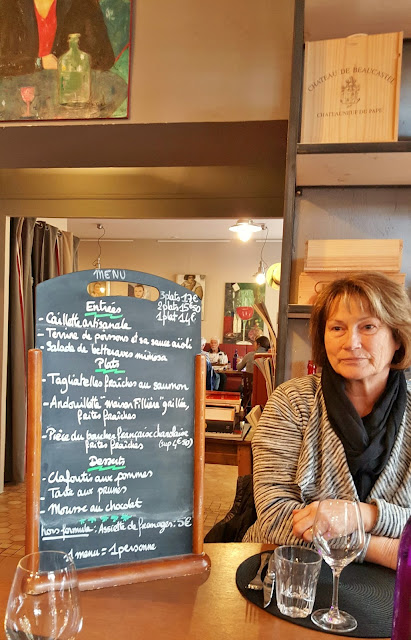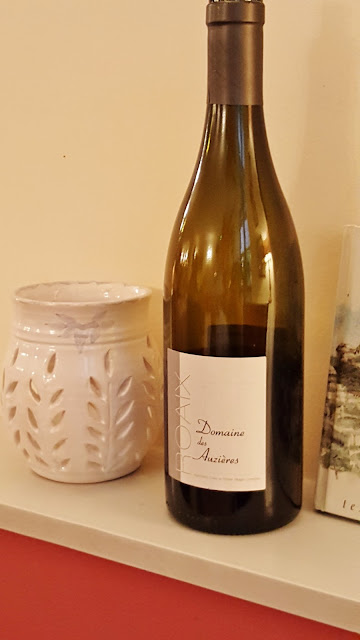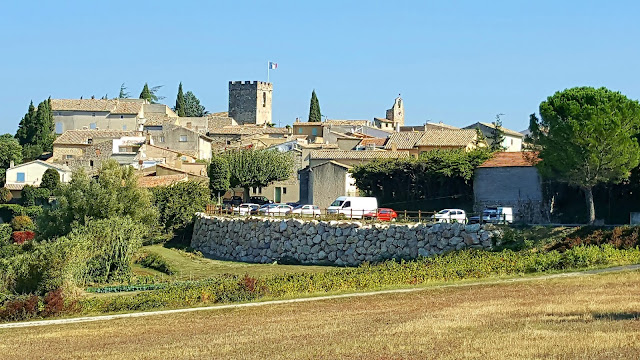Our friends had not tasted in Cairanne so we headed there one morning to explore the village and taste the wines. Cairanne is an old village set in the heart of wine country, on the D8 road crossing the broad Aigues River valley, northeast of Orange and 8 kms west of Sablet.
The oldest part of the village seen below sits on a low hilltop with a magnificent view out across the broad landscape of fields and vineyards, with views of other tiny villages scattered out in the distance. The old village is beautifully restored, keeping the feeling of when the Knights Hospitalers lived here in the 12th century. Only some of the walls remain from the days of the Knights.
The newer part of Cairanne which includes a few shops, the Town Hall, and school sits below the old village on the top of the hill.
 |
| Cairanne |
| Cairanne church |
| Cairanne defensive wall and tower |
The Saint Roch Chapel, built into the old wall besides the Autanne Gate seen below was constructed in 1726 at the end of an epidemic of plague that spared Cairanne. The chapel was dedicated to Saint Roch the patron saint of plagues.
 |
| Autanne Gate |
The ancient bell tower seen below belonged to the Knights Hospitalers. It dates from the 11th century. The building houses a wine museum. It is the oldest building in the village. The door was built at a height that was only accessible by ladder.
 |
| Ancient tower of the Templar Hospitaliers |
The restaurant Le Tourne au Verre is in a strategic location in the center of new Cairanne on Route de Sainte Cécile which is where we headed for lunch. Le Tourne au Verre is a restaurant wine bar with a terrace shaded with 100 year old Sycamores for outdoor dining and a large bar where lunch is served and an adjoining dining room.
 |
| Le Tourne au Verre Restaurant |
The menu changes daily and is presented on a blackboard. There are three choices for starters, main course and dessert. We chose the three course option for 17€, about 18 USD. Diners can also get one course for 14€ or two courses for 15.50€. Prices are higher at dinner.
The restaurant offers over 350 selections of wine by the bottle representing all of the terroirs of the region and over 30 choices of wine by the glass.
 |
| Shirley seated at the table while we make up our minds about what to order |
For our first course we chose the pepper terrine with aioli sauce with greens and
 |
| Pepper terrine with aioli sauce with greens |
the beet and chopped egg salad.
 |
| Beet and chopped egg salad with greens |
For main courses, we chose the fresh tagliatelle with a creamy salmon sauce
 |
| Fresh tagliatelle with a creamy salmon sauce |
and the Charolais beef fillet with frites. This dish had a supplemental charge of 4.50€.
 |
| Charolais beef with frites |
For dessert we chose the chocolate mousse
 |
| Chocolate mousse |
and the prune tart
 |
| Prune tart |
and finally the apple clafoutis.
 |
| Apple clafoutis |
This is simple cooking using locally sourced and seasonal products. Le Tourne au Verre Restaurant provides excellent value in terms of food quality, portions and presentation for the very reasonable price charged for the menu.
As a result, reservations are strongly recommended as the dining rooms fills rapidly. I have called to make reservations on short notice a number of times and heard the words "nous sommes complets" (translated we are fully booked).
Le Tourne au Verre
5 Route de Carpentras
84290 Cairanne
Tel: 04 90 30 72 18
www.letourneauverre.com





























